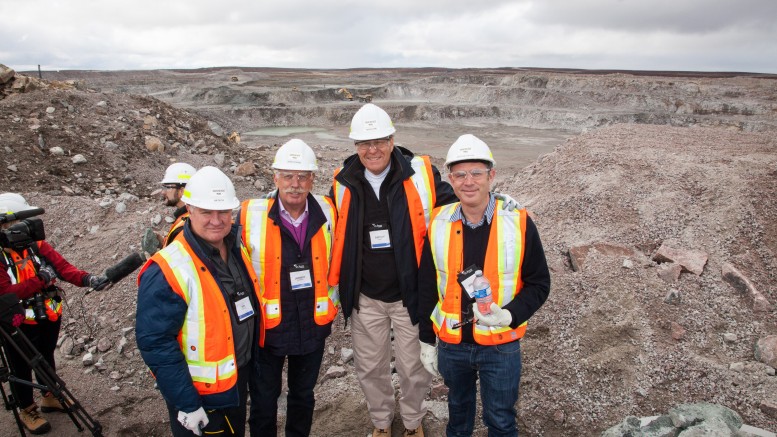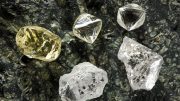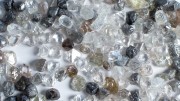It’s been nearly a decade since Canada, the world’s third-largest diamond producer, has added any significant new production.
But this fall has seen two new mines come online within just weeks of each other.
In the Northwest Territories, De Beers and Mountain Province Diamond’s (TSX: MPV; NYSE: MDM) 51%-49%-owned Gahcho Kué mine officially opened in September, while Quebec’s first diamond mine, Stornoway Diamond’s (TSX: SWY) Renard, was slated to celebrate its opening just after presstime in mid-October.
The path from discovery through development to production hasn’t been easy for either project.
“It’s been a very long journey for Mountain Province,” said company president and CEO Patrick Evans in an interview in October, reflecting on the official mine opening. “We discovered Gahcho Kué in 1995,” he noted, adding that he’s been involved with project for 11 of the 21 years that have passed since then. “The feeling I think on the part of just about everyone was enormous satisfaction that we’ve finally been able to bring this asset to account.”
De Beers Group CEO Bruce Cleaver noted in a press release that Gahcho Kué is the diamond giant’s largest ever mine outside of South Africa.
“Allied to our major investments in production capacity
expansion in the southern African region, the opening of Gahcho Kué positions De Beers and its partners strongly to capitalize on the industry’s positive demand outlook,” Cleaver said. De Beers is the operator of the mine.
For Renard, which was discovered by Ashton Mining and Quebec provincial agency SOQUEM in 2001, the path has been a little shorter, but no less harrowing for Stornoway Diamond, which bought Ashton in 2007 and gained 100% of Renard in 2011.
“This company has had a couple of near-death experiences over the last 15 years,” president and CEO Matt Manson told investors at the Denver Gold Forum in September, happily contrasting those experiences with the company’s current position.
Ramping up
Gahcho Kué, which De Beers notes is the world’s largest new diamond mine since 2003, will add 4.5 million carats per year to global diamond production. The $1-billion mine has a 12-year mine life based on probable reserves of 35.4 million tonnes grading 1.57 carats per tonne for 55.5 million carats. Stornoway’s Renard will produce 1.8 million carats per year for its first 10 years of operation. The first mine in Canada that can be accessed by an all-weather road, Renard has a mine life of 14 years based on probable reserves of 22.3 million carats in 33.4 million tonnes grading 67 carats per hundred tonnes.
Construction and ramp-up of both mines has been relatively
smooth, with commercial production expected to be achieved up to six months early at both mines. De Beers is now targeting January 2017 (originally the third quarter of 2017) and Stornoway is targeting year-end at Renard, up from mid-2017 previously.
Despite the positive news, the owners of both mines are cautious about appearing too upbeat too soon.
Manson is mindful that achieving production isn’t the last hurdle the company has to face.
“Everyone’s very conscious that we’ve had a very good build, we had a successful financing, we’ve had a very good construction — ahead of schedule, below budget — but the job’s not done until we’ve demonstrated the potential of the project as an operating mine and that’s a ramp-up process,” he says. “There’s a reason why you don’t just switch on a mine and you’re processing ore at 100% from Day 1.
Now, it has to reconcile its reserves with actual production — something that is much more complicated for a diamond mine than a metals mine.”
Rampup, which started in mid-July — a full 10 weeks ahead of schedule — is a nine-month process.
“To reconcile against our expected dollar revenue, we’ve gotta reconcile, grade, size distribution and quality of diamonds. And then we’re selling these diamonds in a market that goes up and down on a monthly basis — which is a fifth variable on what dollars we get.
“So we’re really at the very beginning stage of understanding what this mine is going to produce.”
At full production, the Renard plant will process 6,000 tonnes a day, with an expansion to 7,000 tonnes per day planned for 2018.
Mining at both operations has been straightforward, but getting the Gahcho Kué diamond plant up to speed has presented run-of-the-mill teething problems.
For example, Evans says, there were some electronic issues with the high-pressure grinding roll in the plant — a problem that necessitated bringing in an engineer from Switzerland.
However, all the technical issues have now either been
resolved or are in the process of being resolved, Evans says. At full production, the plant will handle 8,000 tonnes per day.
At Renard, the main ramp-up issue has been figuring out how to dewater processed kimberlite to create dry-stack tailings.
“The creation of the cake, getting the balance of that right, the quality of the water that’s then extracted, the amount of fine material that’s still in there, what we do with that water — those have been the issues that have caused the principal teething issues that we’ve had to work through,” Manson says. “That’s a work in progress and we’ll get there.”
Actual mining has gone very well with the company mining more kimberlite than expected because of greater volumes of high-grade hypabyssal kimberlite in the country-rock breccia material it’s currently mining and stockpiling.
“It turns out the hypabyssal kimberlite is in there in big 5- to 10-metre wide blocks that we can actually mine selectively. So rather than send that material to a low-grade stockpile, it’s been going to the high-grade stockpile.”
Production for Renard’s third quarter was 111,556 carats attributable to Stornoway. The company will see its first cash flow in mid-November when it has its first diamond sale.
While it will first mine the Renard 2 and Renard 3 kimberlites by open pit until 2018, Stornoway’s mine plan calls for underground mining exclusively at Renard 2 between 2018 and 2027. Develop ment of the ramp at Renard 2 fell behind in late 2015, when the company hit a fault that sent a lot of water into the workings. Development stopped while the company trucked in a few hundred tonnes of grout to plug the leak.
“It hurt us on time but it didn’t hurt us on budget because we have the road,” Manson said, noting that an Arctic mine experiencing the same issue at a time when the ice roads were out of service would have to fly the grout in at a much higher cost.
Development of the ramp fell behind to 72% of plan early this year, but it’s expected to be back on schedule by the end of 2016.
Economic resilience
Gahcho Kué and Renard are starting production in an uncertain time for diamond prices. Last year, rough prices fell by at least 15% and while prices have recovered somewhat in 2016, RBC Capital Markets mining analyst Des Kilalea doesn’t see any upside to prices for the next few years because of sluggish demand outside the U.S. combined with new production coming online by mid-2017 that will total 10 million carats a year. However, the economics of diamond mines are generally quite resilient to any slide in rough diamond prices, Manson notes.
“If you look at the cost curve for the diamond mining business, it’s a higher margin business than most metals sectors — there’s very few truly marginal diamond mines,” he says. “When the diamond price fell 25% during 2015, you didn’t see diamond miners shutting down during that period.”
De Beers’ Snap Lake, which has always been a marginal mine, was the exception, Manson notes. “There are a lot of good projects up in the top two quartiles, and Renard is one of those. I think other sectors in the mining business are less high margin, more exposed to volatility in their commodity price.”
In March 2016, Macquarie Research projected that Gahcho Kué would have an 80% operating margin and Renard a 65% operating margin.
Stornoway pegs its cash operating margin at 59% or $120 per carat.
Helping to insulate both mines from any potential further slide in diamond prices are the special stones — gem-quality diamonds larger than 10.8 carats — that they contain.
At Renard, 21 special stones were recovered in its first quarter of rampup production, while at Gahcho Kué, two special stones were recovered in August at the start of rampup, Evans notes.
“We’ve seen that continue over the last two production months — our first two production months and into October. The number nd quality of special stones is very encouraging, so for example today we received notification from the operator that a 36-carat gem-quality octahedral has been recovered.”
Evans adds: “If we continue to recover these high-value special stones, we can expect to see revenue well above the model price that was assumed in the feasibility study, in that way providing protection even in a softer diamond market.”
Both mines have also benefited from the decline in the Canadian dollar, which helped insulate them from last year’s decline in diamond prices.
“Of course we’re mining in Canadian dollars and selling in U.S. dollars so almost all of that US dollar diamond price drop has been mitigated for us economically by the exchange rate going the other way,” Manson says.
Sales process
As smaller producers, neither Mountain Province nor Stornoway intend to manage the volatility of rough diamond prices by holding back production. Both will be selling their production at open tender in Antwerp through independent broker Bonas-Couzyn.
“We will sell all of our production at the highest price on the day, so we won’t do as some of the other producers have done, which is have reserve prices and hold back in anticipation that the diamond market will improve at some point in the future,” Evans says. “We’ve seen other producers who do that having to take writedowns on inventory, which is obviously not desirable.”
Similarly, Manson says Stornoway will be price takers in the market. As mine operators and the 100% owner of Renard, the company will focus on making the mine as efficient as possible.
“The whole ethos of Stornoway is that we’re a mining company, so we don’t want to get overly focused or invested as a management group in the diamond market,” he explains. “We want to set up a sales process that professionally achieves the highest price on a regular basis, but thereafter, I want the management team of this company and its board to be focused on the mine.”
Manson adds that the company can have the greatest impact by focusing on cost or throughput in the plant or resource expansion rather than squeezing out an extra 1% or 2% from the value of the diamonds.
Kilalea has an outperform rating on Stornoway with a 12-month target of $1.50, while for Mountain Province, he has a sector perform rating and a 12-month target of $8. At presstime Stornoway traded at $1.15 per share with 837 million shares outstanding and Mountain Province traded at $6.80 with 160 million shares outstanding.
—This article originally appeared in the November issue of Diamonds in Canada.





Be the first to comment on "Renard & Gahcho Kué: Two new reasons to celebrate Canadian diamonds"